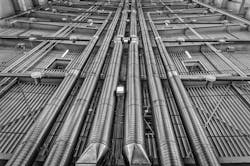Industrial Pipe Repair
About the author:
This article originally appeared in iWWD May 2020 issue as "Industrial Pipe Repair"
The flat gasket repair clamp is often seen as the jack-of-all-trades product for fixing industrial pipes.
No matter what the issue, there is seemingly no repair that a clamp can’t fix – be it a crack, hole or shear break. Many installers see them as a temporary and inexpensive solution for serious pipe breaks, while others believe that the recurring replacement of repair clamps is just a regular occurrence. Some typical applications listed in repair clamp brochures include: coupling plain end pipes; coupling deflected or misaligned pipes; and repairing shear breaks, which push the repair capacities of clamps far beyond their limits.
Shear breaks, separated, misaligned or deflected pipe, and bell and sleeve joint breaks are caused by ground movements or other bending forces exerted on industrial pipe. While a clamp will work when the piping is held in place during repairs, external forces will continue after the repair clamp is installed, which leads to recurring pipe damage, leaks and wasted time and money.
Instead of using piping clamps, see this list of correct repair solutions for industrial repairs to shear breaks, separated, misaligned or deflected pipe, and bell and sleeve joint breaks to ensure they are secure over the long term.
Common Industrial Pipe Breaks
Shear Breaks
Caused by ground movement or other bending forces, shear breaks result in pipes split in two. Section replacements offer a permanent repair compared to a clamp with the dynamic deflection technology helping to absorb ground movement to prevent future breaks. With these kinds of couplings, there is added flexibility on the section of industrial pipe where it is needed most.
The disadvantage of this method is that it is a longer and more expensive repair process. It requires turning off the industrial pipe for a significant period. For a fast and cost-effective solution, an openable split-sleeve coupling with dynamic deflection is a good choice. They can be wrapped around pipe without cutting out or removing sections of pipe, allowing the repair to be made quickly.
The HYMAX VERSA can stab-fit two separate pipes of same or differing materials and diameters or wrap around the damaged section of a pipe. This versatile performance offers a range of options to make repairs quickly and easily under different circumstances and conditions, while also allowing for dynamic deflection to give pipes the capacity to absorb ground shifts.
Separated, Misaligned or Deflected Pipe
Ground movement is the primary cause for these kinds of breaks, and you must consider a coupling with dynamic deflection as defined by Section 3 of AWWA standard C227.
Dynamic deflection allows pipe to deflect angularly post-installation and during the service of the pipeline. By contrast, static deflection coupling allows only for installation on already deflected pipes with the coupling becoming rigid once installed. As with repair solutions for shear breaks, the two repair options are the section replacement method or an openable split-sleeve coupling with its advantages in terms of installation time, cost and ease of use.
Bell & Sleeve Joint Breaks
Bell and sleeve joint breaks can be especially difficult to repair, which requires painstaking attention to detail, especially if the pipe is made from asbestos cement. In these cases, hazmat precautions need to be taken into consideration. Even when not dealing with asbestos cement, repairing leaking bells comes with other complex and costly issues, such as pipeline shutdowns, loss of service notifications, business and community complaints and difficult repair conditions.
According to AWWA standard C227, split-sleeve couplings must have a split cylinder but that does not necessarily make it openable. Openable (or wrap-around) couplings can be wrapped around industrial pipe without cutting out or removing sections of pipe. For bell or sleeve joint repair, the bell or sleeve must first be cut out and then the openable split-sleeve coupling is used to perform the repair.
All three above break descriptions have solutions with their own advantages and disadvantages. The section replacement method works, but is costly in terms of time and expenses. The openable split-sleeve coupling requires shutting down the pipeline, but is easier to install and less costly than the section replacement method. No matter what repair method chosen, however, managers will have a solution that is far more durable compared to clamps, and will find that their industrial systems will be more secure and efficient while saving on repair costs over the long term.
